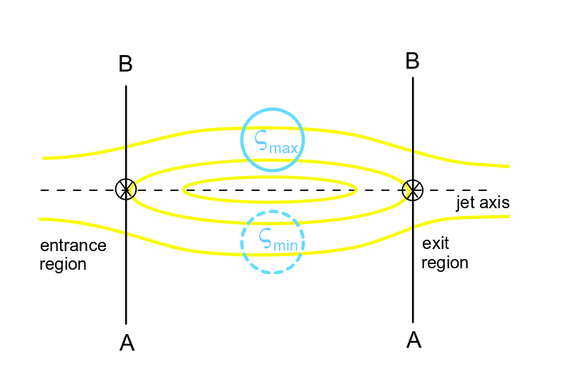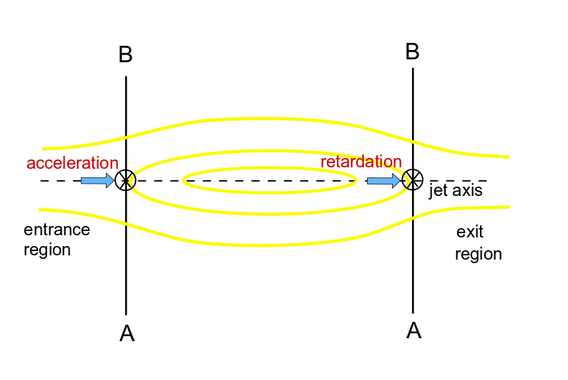Introduction
Jet streaks are the areas of maximum wind speed within the jet streams. Because of the increase of wind speed in jet level in the upstream part of the streak and the decrease in the downstream part there are four areas of the streak which show differences of divergence and convergence, of vorticity advection and upward motion; the development of ageostrophic winds lead to the development of vertical cross sections perpendicular to the jet streak. Uccellini and Johnson (building up on earlier authors) are connected with this four-quadrant jet streak model.
Jet streaks can be straight and curved. For typical cloud configurations and Conceptual models (CMs) in satellite images the best relation can be seen with the straight or only weakly curved jet streaks. The main parameter connected to jet and jet streaks is wind shear and shear vorticity while in curved streaks curvature vorticity becomes important. Both types of vorticity have to be added then and consequently the four-quadrant model is corrupted then.
1. Jet streaks and distribution of vorticity and vorticity advection in jet level
Figure 1: Vorticity maximum and minimum to the north and to the south of the jet stream
The upstream side of the jet streak is the "entrance region" where air particles enter the jet streak; the downstream side is the "exit region" where the particles leave the jet streak.
Because of the increased wind speed in the centre of the jet streak a maximum of vorticity develops at the cyclonic jet centre and a minimum of vorticity at the anticyclonic jet centre.
Figure 2: Areas of cyclonic (CVA) and anticyclonic vorticity advection (AVA)
As the jet streak is moving in direction of the general stream there appears a maximum of cyclonic vorticity advection (CVA) downstream of the vorticity maximum on the cyclonic side of the jet streak in the left exit region. Also, on the anticyclonic side of the jet streak in the right entrance region a CVA maximum can be noticed which means that it becomes less anticyclonic there. In the other two quadrants, maxima of AVA representing areas where it becomes less cyclonic.
The parameter of vorticity advection is important as it is via the omega equation (link in Basis chapter) connected with vertical motion and especially CVA with upward motion.
2. Stream components at the jet level
Figure 3: Acceleration area at the entrance and retardation area at the exit of the jet stream
Figure 4: Dark blue: Acceleration wind vector; Red: Ageostrophic wind vector; Light blue: Resulting wind vector
Because of acceleration and deceleration ageostrophic winds develop which lead to a resulting wind vector that point in the jet level:
- in the entrance region from the anticyclonic to the cyclonic side
- in the exit region from the cyclonic to the anticyclonic side
3. Vertical cross sections in entrance und exit region
 |
 |
Figure 5:
With these considerations in the jet level two corresponding vertical circulation cells can be defined:
|
In the entrance region:
The right entrance region is preferred area for classical wave developments for instance in a cyclogenesis according to the classical polar front theory; they usually can have longer development times. |
|
In the exit region:
The left exit region is a preferred area for rapid and intensive developments for instance in a rapid cyclogenesis, or for the development of Cold Air Conceptual Models like ECs and commas |



